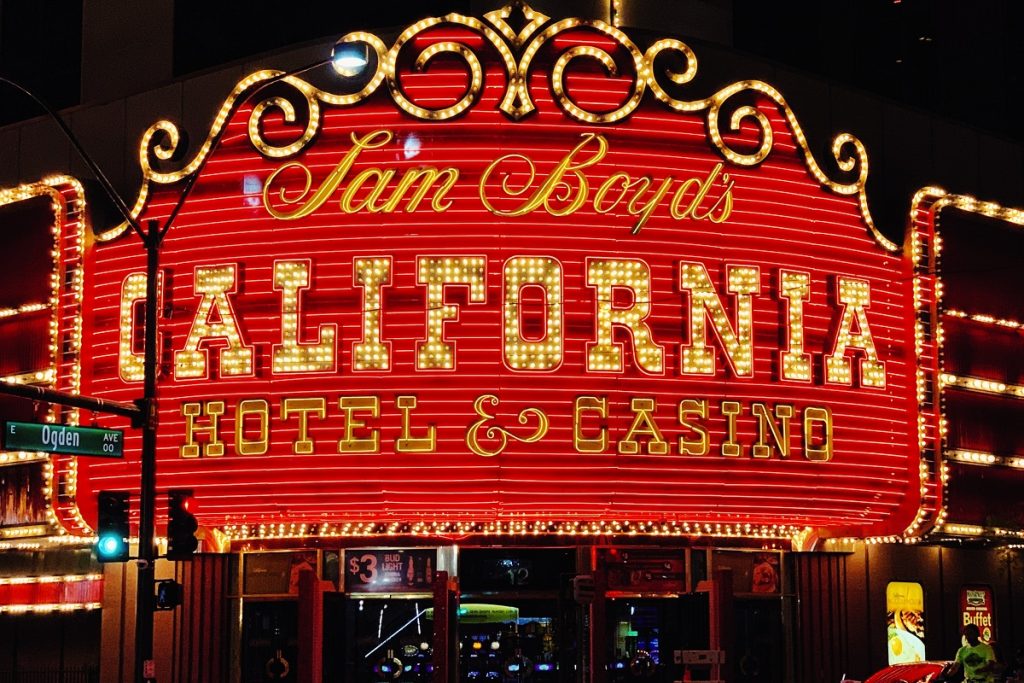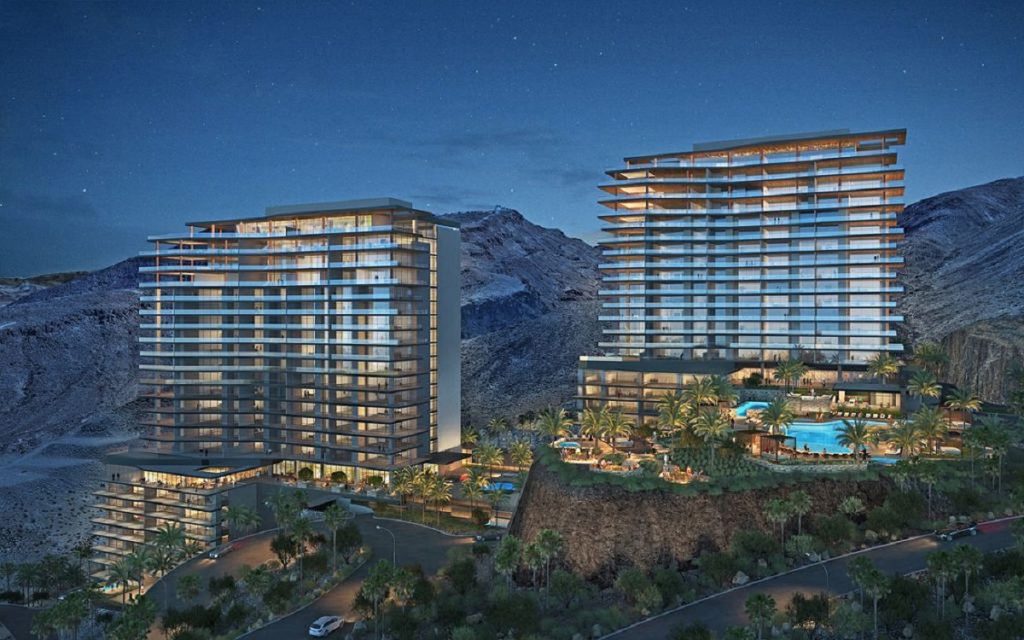Viva Vegas!
Las Vegas sprouted in the early 20th century as a humble railway settlement. The advent of the Union Pacific Railroad ignited the city’s growth, bridging the eastern and western United States. Its strategic position cemented Las Vegas as a linchpin for trade and conveyance. This lead to a bolstering of the local economy. Notwithstanding its humble inception, Las Vegas rapidly garnered fame for its flourishing gaming milieu. Nevada sanctioned gambling in 1931, clearing the path for casino construction and the gaming sector’s expansion. The Las Vegas Boulevard, now emblematic of glitz and glamour, materialized in the 1940s. It was then we saw the birth of hotel casinos like the Flamingo and Desert Inn. These establishments lured visitors, metamorphosing the city into a globally celebrated destination.
The Rat Pack and Las Vegas’ Gilded Epoch
Las Vegas’ heyday spanned the 1950s and 1960s. It featured renowned artists such as Frank Sinatra, Dean Martin, and Sammy Davis Jr. They were collectively dubbed the Rat Pack, adorning the stages of the city’s iconic venues. This period experienced an influx of opulent casinos and luxury resorts, including the Sands, the Dunes, and the Stardust. The Rat Pack’s aura, amalgamated with the city’s ever-expanding gaming and entertainment attractions, fortified Las Vegas’ stature as a prime touristic magnet.

Sam Boyd’s California Hotel & Casino Opened In 1975
The Mob’s Role
The mafia’s role in Vegas history began when mobsters such as Meyer Lansky and Bugsy Siegel arrived on the scene in the 1940s. They began investing heavily in nightclubs, hotels, and casinos. These investments quickly paid off, and Las Vegas became a major destination for people looking to gamble and have a good time. The mobsters’ influence was so significant that they even had a hand in constructing many iconic landmarks, such as The Sands Hotel and the Flamingo.
The mafia’s influence in Vegas was not always positive, however. There were numerous reports of mobsters getting involved in organized crime activities, such as extortion and illegal gambling. This led to Las Vegas becoming known as a crime-ridden city for many years. Despite this, the mafia’s influence in Vegas has helped to shape the city as we know it today. The casinos, hotels, and other attractions all owe a debt of gratitude to the men who built this city.
Howard Hughes Era
The next stage of Las Vegas was the Howard Hughes era. Howard flew into town on his custom-built plane in the early 1960s and began buying large amounts of real estate. He eventually owned many of the iconic landmarks the mobsters had built, which signaled a new era in Vegas history. The government stepped in with more regulations, which limited some of the mob’s influence. New corporate hotel brands such as the Hilton came into town. It was the end of the time when The Strip was fancy motels with neon signs. These were actual corporate hotels; the city was maturing.
Steve Wynn & The Resort Surge
The late 1980s and 1990s witnessed a transformation in Las Vegas’ terrain. Older casinos and hotels conceded to sprawling colossal resorts. The Mirage, unveiled in 1989, heralded this novel time of development, boasting a vast casino, an opulent hotel, and a volcanic spectacle. In fact, us locals consider Steve Wynn’s idea of The Mirage to be legendary. Nobody believed in his idea, to monetize everything from entertainment to dining to rooms, etc. He changed this city forever. Soon we saw establishments like the MGM Grand, Luxor, and Bellagio. These new properties flaunted luxurious facilities and groundbreaking attractions that forever altered Las Vegas’ visage. All because of Steve Wynn. It was a magical time.
Family-Centric Las Vegas: A Reorientation Of Priorities
In the 1990s, Las Vegas began to pivot towards families. Developers and resort proprietors aimed to cultivate an inclusive ambiance for guests spanning all age brackets. Attractions like the Adventuredome at Circus Circus, the Shark Reef Aquarium at Mandalay Bay, and the roller coaster at New York-New York materialized. These destinations catered to families, offering a diverse assortment of entertainment options beyond gaming. Eventually, this time period was revealed to be just that. With Vegas again changing.

The Four Seasons Private Residences Is The First High-Rise Project To Be Built In Las Vegas Since The 2008 Housing Crisis
High-Rise Boom Of 2006
Around 2005, developers started talking about building high-rise condos in Vegas. Even more shocking, publicly traded corporations such as Sands Corp and MGM MIRAGE announced residential real estate projects to be built on their prime-Strip land. To understand the absurdity of this, one has to understand why land on the Las Vegas Strip is so valuable. There are reasons it’s limited to 4 miles. And there’s a reason why old projects are torn down to make room for new ones, because there really is nowhere else as lucrative to build the, The Strip is where it is at.
The high-rise boom lead to the construction of several great projects such as Veer Towers, One Queensridge Place. and the under-construction Four Seasons Private Residences Las Vegas. It also led to many canceled projects (from developers flipping the land and running).
2008 Economic Collapse And Recovery
Las Vegas reeled from the 2008 financial meltdown, precipitating a drastic drop in tourism and enfeebling the city’s economy. However, the subsequent years showcased Las Vegas’ extraordinary tenacity. The metropolis concentrated on broadening its economic base by investing in technology, healthcare, and renewable energy domains. This diversification, amalgamated with the continuous augmentation of the city’s tourism amenities, has enabled Las Vegas to regain its equilibrium and reemerge more robustly than ever. Additionally, Vegas now has legalized marijuana and pro sports. These are both big booms for the local economy.
Questions And Answers
When was wagering authorized in Las Vegas?
Nevada legalized gambling in 1931, laying the foundation for the city’s thriving gaming sector. The gaming industry has since become an integral part of the state economy, employing thousands of people and generating billions in tax revenue. Casinos offer table games like blackjack, roulette, craps, slot machines, bingo, and sports betting. In addition to the traditional casino staples, Nevada’s resorts offer some of the world’s most extravagant shows and entertainment experiences.
What role did the Rat Pack play in Las Vegas’ narrative?
The Rat Pack, an ensemble of legendary performers including Frank Sinatra, Dean Martin, and Sammy Davis Jr., was instrumental in establishing Las Vegas as a preeminent entertainment destination. This took place during the city’s golden era (the 1950s and 1960s).
What instigated the construction of colossal resorts in Las Vegas?
The edification of colossal resorts in Las Vegas arose from the aspiration to create grandiose, luxurious establishments catering to a diverse clientele. The Mirage, inaugurated in 1989, ignited this trend, paving the path for iconic properties like the MGM Grand, the Luxor, and the Bellagio.
How did Las Vegas evolve to become more family-centric?
Las Vegas began a family-centric transition in the 1990s. Developers and resort proprietors devised attractions such as the Adventuredome at Circus Circus, the Shark Reef Aquarium at Mandalay Bay, and the roller coaster at New York-New York, catering to visitors across all age groups.
How did Las Vegas rebound from the 2008 economic crisis?
Las Vegas recuperated from the 2008 financial crisis by diversifying its economy and injecting capital into industries like technology, healthcare, and renewable energy. This strategy and the ongoing expansion of its tourism offerings helped the city regain stability and reemerge better than ever.
The Metamorphosis of Las Vegas: An Extraordinary Revolution
In summary, Las Vegas’ chronicle is characterized by a sequence of extraordinary metamorphoses. It has gone from modest origins as a humble railway settlement to the wagering capital of the world. The city’s golden era, marked by the Rat Pack’s presence and the edification of legendary casinos and hotels, solidified its reputation as a premier entertainment destination.
The construction of colossal resorts and the reorientation towards a more family-centric environment further diversified the city’s allure. Despite challenges such as the 2008 financial crisis, Las Vegas has exhibited remarkable tenacity and continues growing as a globally renowned tourist destination, displaying its ever-evolving landscape and rich history.
Today, Las Vegas has so much going for it is not even funny. If you’d like to learn about the local real estate market, I’m here to answer any questions you may have.


